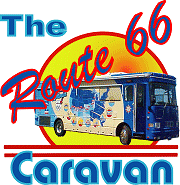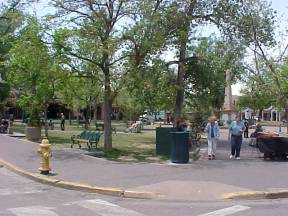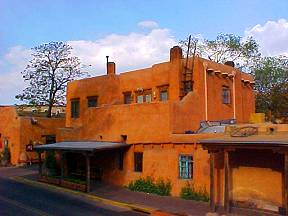 |
America's Biggest Road Trip! |
Route 66
Caravan Road Log:
|
 |
America's Biggest Road Trip! |
Route 66
Caravan Road Log:
|
Pre-1937 Route 66 |
||
We left Santa Rosa and continued on towards Santa Fe on the old pre-1937 alignment of Route 66. For over a decade this was Route 66. The story of how and why it was changed is one of the most interesting pieces of road lore that I've heard. |
||
|
| When Route 66 was first laid out in 1926, everybody knew it would go through the capital of New Mexico and indeed it did. Route 66 followed the Old Pecos Trail from Santa Rosa through Dilia, Romeroville and Pecos to Santa Fe. From Santa Fe it went over La Bajada Hill and down into Albuquerque. That was the way it was aligned and constructed and that was the way it was supposed to stay - forever. But it didn't. | ||||
|
But why was it moved? One popular story involves a case of revenge that achieved monumental proportions. In 1927 the then governor of New Mexico, Governor Hannett, lost the re-election. Hannett blamed this on the politicians in Santa Fe. In one great last act of defiance before the new governor was sworn in he vowed to get even with this Santa Fe ring. | |||
| He had until January to institute his revenge. And he did! He decided the best way to get even was to re-route Highway 66 to Albuquerque and bypass Santa Fe altogether. This new alignment would bypass the Santa Fe businesses and Santa Fe politicians. It was a race against time. With no time off for the workers, including Christmas, he had to build a road through the virgin landscape fighting the elements, the vegetation and anybody and anything that got in his way. There was no time to buy the right a way so the road cut across both public and private land with no regard for the ownership. Though the road was not quite finished by the time the new governor took office in January, bad weather conditions prevented him from contacting the work crews to stop the project. By the time the new governor met with the work crews it was too late. | ||||
| The new road had been finished and cars were already driving the new route that cut off more than 90 miles of driving distance between Santa Rosa and Albuquerque. Santa Fe had been bypassed! The new alignment was really a better route from an engineer's standpoint. It was a more direct route that cut out some treacherous road conditions. It was also quite a bit shorter. By 1938 when Route 66 was paved this segment was officially designated Route 66. This is the route that would be followed by Interstate-40 years later. Now you know the whole story! |
|
|||
Pre-1937 Route 66 in Santa Fe passes right by the La Fonda Hotel. |
||||
Fred Harvey's La Fonda Inn |
||||
|
||||
| There has been an inn or fonda on this corner next to Santa Fe's historic plaza since 1610. Throughout the days of the Santa Fe Trail, the California Gold Rush, and New Mexico territory travelers have come to this corner in Santa Fe for lodging and rest. The last inn on the corner before today's La Fonda was destroyed in 1919. The present day La Fonda was built on the site in 1920. After the business venture failed the Atchison, Topeka and Santa Fe Railroad acquired the hotel, which they then leased to Fred Harvey in 1926. From 1926 through 1969 the La Fonda was one of the famous Harvey Houses. During those early years the La Fonda served as headquarters for Fred Harvey's Indian Detours. Passenger would take the Santa Fe Railroad and disembark at the La Fonda for a touring car adventure into Indian Country. This service allowed cross-country rail travelers an opportunity to tour Southwestern attractions including Indian Pueblos, Indian Ruins, and even Carlsbad Caverns. It was a marketing ploy that was highly successful during the 1930s and 40s. | ||||
|
|
|||
Miraculous Staircase of Loretto Chapel |
||||
|
The Year was 1873 and the Loretto Chapel was almost complete. There was one problem though. The choir loft, 22 feet above the chapel floor, could not be accessed. The builders concluded that a ladder would have to be constructed to the loft because there was no room for a staircase. This was unacceptable to the sisters and a special novena to St. Joseph, patron saint of carpenters, was held. On the final day of the novena a man showed up looking for work. The sisters hired him to build the staircase. |
|||
| After months of work the man had built a beautiful circular staircase to the choir loft. Then the man then disappeared without a trace without being paid for his work. The sisters searched for him to no avail. Some concluded that he was Saint Joseph himself because of the impossible design of the elegant staircase. This design still perplexes engineers today. The staircase has two 360 degree turns and has no visible means of support and the staircase was built without nails, only wooden pegs. Today people from all over the world flock to the Loretto Chapel to see this miraculous staircase. | ||||
Santa Fe's Old Town |
||||
 |
Though Santa Fe lost its place on Route 66 in 1938, it remains one of the most picturesque cities in New Mexico, steeped with the mystery and romance of a colorful history. The Native American and Spanish Colonial influence can be seen everywhere. | |||
| Founded in 1610 on the ruins of an abandoned Tanoan Indian village, Santa Fe has been a capitol for nearly four hundred years making it the oldest capitol in the United States. The Palace of the Governors was constructed between 1610 and 1612 and is the oldest government building in the country. |
|
|||
|
|
|||
 |
Once this town was the end of the old Santa Fe Trail (a portion of which was shared by Route 66 between 1926 and 1937), an exotic destination luring the earliest Anglo explorers and traders west. The Santa Fe trail was the earliest trade route linking the American frontier back east with the far west. | |||
| The Santa Fe Trail would serve as part of the southern route to California during the gold rush of 1849, followed by the railroads in the 1880s and in turn the old trail would inspire the building of a national highway that would later become Route 66. | ||||
 Previous Log |
Road Log pages read like a book:Follow the Route 66 Caravan
|
|
||||
|
||||||
66 Caravan Web Site Written, Photographed & Designed by Guy Randall |
||||||
© 2003 Design and Updates by ![]() GRandall Web Design
GRandall Web Design